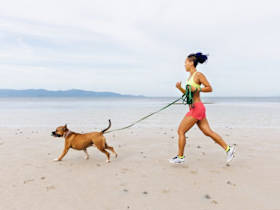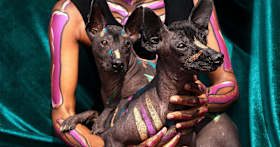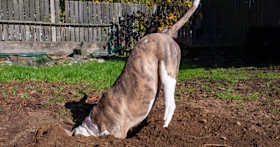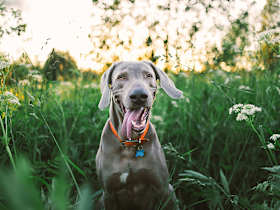Best Dogs for Hot Weather
Whether you live in the desert or a more tropical environment, these are the best dogs for your climate.
Whether you live in the desert or a more tropical environment, these are the best dogs for your climate.
by Nisha Gopalan, | January 7, 2025

Anna / Adobe Stock
If you live in a place where it’s hot — either a dry locale or a humid one — it’s important to adopt a dog who can handle the heat. Why? Because even a routine walk can be dangerous for certain types of dogs, at its worst, resulting in heatstroke.
Below, we explain which breeds (and mixes) tend to endure those scorching dog days a little more comfortably and those better off avoiding these climates altogether. We’ll also help you identify the warning signs that your dog may not be weathering the heat very well, as well as tips on how to keep your pup cool to avoid any risk from the get-go.
Dogs best suited for hot weather generally have naturally short and/or single coats. This coat type encourages air circulation, so the pup will not retain too much heat. To that end, dogs with lighter-colored coats (white, tan, gray) should keep cooler than a darker coat. And when they have ears that stand up, rather than floppy ones, that also encourages circulation, better regulating the dog’s internal temperature.
What’s great is that there are plenty of dogs who thrive in warm climates in shelters across the country. Mixed breeds may assume the physical characteristics of both their parents, so you’ll have to carefully observe their tolerance to heat. Additionally, it is important to keep any dog — even the most tolerant, warm-weather dog breeds — well-hydrated, with plenty of opportunities to relax in the shade.
If you’re an outdoorsy person who lives in a sometimes-sweltering environment, these large dog breeds may be the right fit for your lifestyle.

Igor Madjinca / Stocksy
These loyal, energetic, short-haired pups thrive in warmer climates. Be prepared to train your Dalmatian through their stubborn streaks, and keep these outgoing pups well-behaved with plenty of exercise.
Weight: 45-70 pounds
Height: 23-24 inches
Lifespan: 11-13 years
Browse for Dalmatians (and their mixes) for adoption

Danil Nevsky / Stocksy
Much like humans, the Great Dane would rather lounge around during hot weather so as not to overexert themselves. Because of this (plus their short hair), they’re considered one of the best dogs for warmer climates. To that end, sunbathing is one of this gentle giant’s favorite pastimes.
Weight: 95-153 pounds
Height: 29-35 inches
Lifespan: 6-10 years
Browse for Great Danes (and their mixes) for adoption

Jose Coello / Stocksy
This kind-natured breed is known for sprinting as quickly as 45 miles per hour. In fact, Greyhounds have such a superior cooling system (thanks to their Egyptian roots and sleek, short hair) that they can even run effortlessly in warm climates — though, let’s be real, these couch potatoes probably prefer just to lounge around.
Weight: 54-83 pounds
Height: 27-30 inches
Lifespan: 10-13 years
Browse for Greyhounds (and their mixes) for adoption

Jordi / AdobeStock
Originally hailing from Egypt, the athletic Ibizan Hound is a reliable jogging buddy who can persevere even on warmer days, thanks to their short, often lighter-colored coat and erect ears. This svelte pup comes ready to race, so they’ll fit well in active families.
Weight: 33-64 pounds
Height: 22-29 inches
Lifespan: 11-14 years
Browse for Ibizan Hounds (and their mixes) for adoption

Oksana / AdobeStock
Hailing from Mexico, Xolos are loyal, sweet, and chill — calm at home but always game for a long walk. The standard (or bigger) sized Xoloitzcuintli come either hairless or with short hair, making them great warm-weather dogs who are relatively hypoallergenic, too.
Weight: 10-40 pounds
Height: 10-24 inches
Lifespan: 13-18 years
Active and affectionate, these medium dog breeds live for warm summer afternoons outside.

Irina Nedikova / Shutterstock
Australian Cattle Dogs are famous for their intelligence and boundless energy. Born with double coats that regulate their body temperatures in the heat, this pup loves to be put to work, so prepare for outdoor activities — even on a lazy summer day.
Weight: 31-53 pounds
Height: 17-20 inches
Lifespan: 12-16 years
Browse for Australian Cattle Dogs (and their mixes) for adoption

Susana Ramírez / Stocksy
Smart and athletic, Border Collies are herding dogs of the most agile and affectionate sort. They thrive playing sports and games with mental challenges, then wind down by snuggling with the whole family, no matter the weather.
Weight: 31-53 pounds
Height: 18-21 inches
Lifespan: 12-15 years

David Keller / Stocksy
Often referred to as “barkless” dogs, Basenji (who do make noises, just not barking ones) have fine coats and pointy ears seemingly tailor-made for warm environs — a nod to their African heritage. This compact hound is independent and famously graceful, so it’s best to indulge their need for prancing around.
Weight: 16-34 pounds
Height: 15-17 inches
Lifespan: 12-14 years
Browse for Basenjis (and their mixes) for adoption

Jovo Jovanovic / Stocksy
With no undercoat beneath their fur, the sweet-natured German Shorthaired Pointer is an excellent family dog who loves going out in warm weather. This breed is active with a capital A, and swimming (their favorite pastime) is a great way to sate their appetite for activity — not to mention that it helps them stay cool.
Weight: 42-79 pounds
Height: 21-25 inches
Lifespan: 10-14 years
Browse for German Shorthaired Pointers (and their mixes) for adoption

Tierfotoagentur / Alamy Stock Photo
The “v” in Vizsla also stands for “Velcro” since this good-natured pup loves hanging out with their human family. But these former hunting companions are also quite athletic, so prepare to spend plenty of quality hours outdoors with your Vizsla, who comes with a smooth coat made for hot days.
Weight: 46-73 pounds
Height: 21-25 inches
Lifespan: 12-15 years
Browse for Vizslas (and their mixes) for adoption
If you’re a fan of all things teeny, consider these smaller pups, who are the best dog breeds for tropics and arid spots alike, below.

niknikp / AdobeStock
This bald dog is content sitting on your lap, hanging out with your kids, or playing fetch. (Bonus: They’re also mostly hypoallergenic.) American Hairless Terriers are great on walks and just as energetic as you’d expect them to be in warm weather.
Weight: 7-17 pounds
Height: 7-16 inches
Lifespan: 14-16 years
Browse for American Hairless Terriers (and their mixes) for adoption

Lesia / AdobeStock
Despite their petite stature, Chihuahuas have big personalities and, with their erect ears and light coats, possess an enviable ability to tolerate heat. These family-friendly dogs love to play, but given their size, pet parents should make sure not to physically overwork them.
Weight: 2-9 pounds
Height: 6-9 inches
Lifespan: 14-20 years
Browse for Chihuahuas (and their mixes) for adoption

Dogs / AdobeStock
Chinese Cresteds were bred in China from hairless African dogs, which makes these toy dogs total champs in the heat. Distinctly adorable for their spiky, punk–rock hairdos, these pups are loving and playful, enjoying some (but not too much) exercise.
Weight: 7-16 pounds
Height: 9-13 inches
Lifespan: 13-18 years

RonPaulk Photography / AdobeStock
The Italian Greyhound is much more in their element in hotter weather than in colder climates due to their thin coat and lithe physique. This sprightly, affectionate dog is elegant in form, loves running around the house, and is generally quite comfortable outdoors in warm weather.
Weight: 5-14 pounds
Height: 12-15 inches
Lifespan: 14-15 years
Browse for Italian Greyhounds (and their mixes) for adoption

Nicole Mlakar / Stocksy
Though the Papillon may be challenged in oppressively hot weather, their thin, single coat makes them quite tolerant in warmer environments. This happy, playful breed takes well to training — helpful in socializing them — and will readily burn off energy learning new tricks.
Weight: 4-12 pounds
Height: 8-11 inches
Lifespan: 12-16 years
Browse for Papillons (and their mixes) for adoption
If your dog isn’t built for hot weather, exposing them to too much heat can lead to dire circumstances. Here are the types of pups you should avoid adopting if you live in more-than-balmy areas.
Brachycephalic (or short-nosed) breeds: Bulldogs, Boxers, Pugs, Boston Terriers, Shih Tzus, and Cavalier King Charles Spaniels are some of the worst breeds for hot weather because all have short noses, which means they don’t breathe efficiently. Due to their narrow airways, they have a hard time cooling themselves by panting. This puts them at great risk for heatstroke.
Dogs with heart or upper respiratory problems: Any breed of dog with congenital or developed breathing-related issues is considered high risk for the same reason as Brachycephalic breeds; Canines use their respiratory system to regulate heat, and here, it is compromised.
Dogs with thick coats: While coats can temperature-regulate dogs, double coats in breeds such as Labradors, Huskies, and Shepherds have the potential to insulate them to the point of overheating. (A darker coat could exacerbate this effect.) This is because the outer coat may not shed as much as the inner coat.
Obesity: Overweight or obese dogs are less likely to do well in the heat because fat cells provide increased insulation, and mild exercise might generate more heat.
Very old or young dogs: Senior dogs may have issues with temperature regulation due to medical issues or simply a weaker constitution. Meanwhile, high-energy puppies will also have trouble regulating their body temperatures.
Heatstroke is a condition in which your dog’s body overheats. This can be due to exposing your dog to outdoor heat that they cannot handle, and it can be caused by leaving them in closed quarters (typically, a car) with poor ventilation.
These situations cause a dog’s body temperature to rise quickly. In this case, your dog’s body temperature — which should be 101°F to 102.5°F — may rise to a dangerous 106°F. Heatstroke is a very serious condition that can lead to organ damage or even death.
Needless to say, if you suspect your dog has heatstroke, take them to a vet immediately. Other signs of heatstroke in dogs include:
Intense panting or difficulty breathing
Their gum and/or tongue turning red or purple
Diarrhea
Extreme lethargy or collapsing
Excessive drooling
Vomiting
A seizure
Some environments may be warm and humid year-round, but for most pet parents, summertime is when the climate transforms from temperate to scorching. Here are some tips to better protect your dog during those months.
Make sure your dog is hydrated, and always bring water on walks.
During hotter days, keep your walks short and avoid prolonged exercise. Try walking your dog on grass or dirt. If you’re in an area surrounded by asphalt, use paw balm or booties to protect your dog’s paws.
Invest in a cooling vest, which you soak in water. As the water evaporates, it cools your dog.
If your dog has a thick coat, regularly brush and bathe them to loosen any shedding. This promotes better air circulation.
Keep your dog indoors, where it’s cooler and mostly free of direct sunlight.
It’s a very bad idea to leave your dog in your vehicle, especially during warmer months. Even if it seems temperate outside, the inside of your car will be much hotter. (Leaving your dog in a truck bed, which gets hot despite being open-air, is also a no-no.)
While trimming your dog’s coat is just fine, the American Society for the Prevention of Cruelty to Animals (ASPCA) discourages pet parents from shaving off their dog’s fur because it’s their only line of defense. “Acting like insulation, a dog’s coat keeps him from getting too cold in the winter, but also keeps him from overheating in the summer,” the ASPCA writes, adding that this also prevents sunburn and skin cancer. On the other hand, if you have a hairless dog, invest in some dog-safe sunscreen for them.
The temperature that is too hot for leaving a dog in a car will vary based on a pet’s breed, constitution, health, age, and other factors. The American Veterinary Association recommends never leaving your dog alone in a car, because temperature fluctuations are very dramatic. For instance, the temperature inside your car can increase by 20°F in only 10 minutes. Even leaving a window cracked will not cool your dog.
Deciding which temperature is too hot for your dog’s paws will vary, but the American Kennel Association states that you should take precautions when the outside temperature reaches 85°F. (In contrast, 70°F is considered ideal — not too hot, not too cold.) Failure to protect your dog’s paws could result in discomfort, blisters, or burns.
“15 Flat-Faced Dog Breeds.” PetMD, www.petmd.com/dog/general-health/flat-faced-dogs.
“Five Tips to Keep Your Dog Safe from the Summer Heat | Animal Humane Society.” www.animalhumanesociety.org/resource/five-tips-keep-your-dog-safe-summer-heat.
Gewirtz, Elaine Waldorf. “Best Dog Breeds for Hot Weather.” American Kennel Club, 29 Aug. 2024, www.akc.org/expert-advice/dog-breeds/best-dog-breeds-for-hot-weather/.
“Heat Stroke in Dogs.” VCA Corporate, vcahospitals.com/know-your-pet/heat-stroke-in-dogs.
“Heat Wave Approaching! Should You Shave Your Pet?” ASPCA, www.aspca.org/news/heat-wave-approaching-should-you-shave-your-pet.
“How to Keep Dogs Cool in Hot Weather.” Best Friends Animal Society - Save Them All, 2024, bestfriends.org/pet-care-resources/how-keep-dogs-cool-hot-weather.
“How to Protect Dog Paws from Hot Pavement, Sidewalks.” American Kennel Club, www.akc.org/expert-advice/health/dog-paws-hot-pavement/.
“Papillon | Dog Breed Facts and Information - Wag! Dog Walking.” WagWalking, Wag!, 31 Aug. 2006, wagwalking.com/breed/papillon. Accessed 2 Dec. 2024.
“Pets in Vehicles.” American Veterinary Medical Association, www.avma.org/resources-tools/pet-owners/petcare/pets-vehicles.
“Protecting Your Pet during Hot Weather.” Ca.gov, 2024, www.cdph.ca.gov/Programs/EPO/Pages/Extreme%20Heat%20Pages/BI_Natural-Disasters_Extreme-Heat_Protect-your-Pet.aspx.
“Types of Pets That Are Extra Sensitive to Warm Weather.” BC SPCA, spca.bc.ca/news/dogs-sensitive-hot-weather/.

Nisha Gopalan has been a writer/editor for The New York Times, New York magazine, Entertainment Weekly, Variety, The Hollywood Reporter, and NYLON magazines. She currently resides in Los Angeles.

Breed Info

Breed Info

Breed Info

Adoption Advice
Here’s how to be prepared in the event that your dog or cat has an emergency or suffers an injury.

Breed Info
Are you an extroverted pet-parent-in-the-making looking for a loveable, outgoing pup? Scroll down to meet the friendliest dog breeds who’ll make your life that much more enriching.

Behavior & Training

Adoption Advice
Getting a dog can be the best thing you ever do — if you’re prepared.

Breed Info
Want a dog who sticks to you like glue? We’ve got just the breeds for you. Below, our shortlist of some of the most adoring canine breeds.

Adoption Advice
Here are a few of the best gray names for dogs.